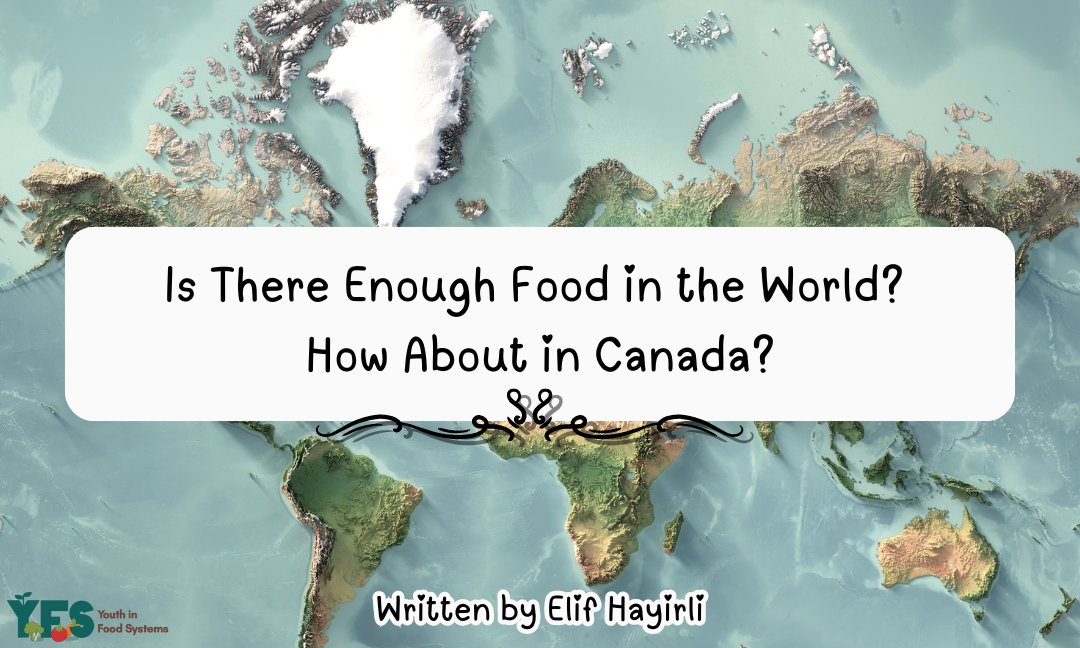Written by: Elif Hayirli
Edited by: Nirek Deepak
Designed by: Eleanor Jeavons
Published by: Rayna Almas
Food security is a pressing issue that affects every corner of the globe, including Canada. With a growing global population and increasingly complex supply chains, many wonder: Is there enough food in the world to go around? And what about right here in Canada?
Global Food Supply: The Big Picture
At first glance, it might seem like there’s plenty of food globally. According to the Food and Agriculture Organization (FAO), the world produces enough food to feed everyone. However, the problem isn’t just about quantity—it’s about distribution and access.
Many regions struggle with food insecurity due to factors like economic instability, climate change, and poor infrastructure. In some areas, food might be plentiful, but political or logistical barriers prevent it from reaching those in need. The FAO estimates that about 828 million people globally are undernourished, highlighting a significant gap between food availability and food access.
Food Distribution Challenges
The global food distribution system is incredibly complex. Food production occurs in one part of the world, while consumption happens elsewhere. Disruptions in this supply chain, whether from natural disasters, trade disputes, or logistical issues, can lead to shortages in some areas even when overall production is sufficient.
Moreover, food wastage is a major issue. According to the FAO, around one-third of all food produced is lost or wasted. This not only represents a waste of resources but also exacerbates food insecurity. Efficient food distribution and reducing waste are crucial for addressing global food challenges.
Food Security in Canada
In Canada, food security is generally higher than in many parts of the world, but it is not without its own challenges. The country is known for its abundant food supply, thanks to its large agricultural sector and advanced supply chains. However, food insecurity still affects a portion of the population.
The Reality in Canada
According to the 2021 report from the Canadian Community Health Survey, approximately 12% of Canadian households experienced food insecurity at some point in 2021. This statistic underscores that while food might be available, access is not guaranteed for everyone.
Several factors contribute to food insecurity in Canada:
- Economic Barriers: High food prices and low-income levels can prevent people from affording sufficient and nutritious food.
- Geographic Barriers: In remote or northern communities, access to fresh, affordable food can be limited, leading to higher rates of food insecurity.
- Indigenous Communities: Many Indigenous communities face unique challenges related to food security, including historical and systemic issues that impact their access to healthy food.
Efforts to Improve Food Security
In Canada, various initiatives aim to tackle food insecurity and improve food access:
- Food Banks and Community Programs: Organizations like Food Banks Canada provide critical support to those in need, offering emergency food supplies and other resources.
- Government Programs: Programs like the Canada Child Benefit and provincial social assistance programs help low-income families afford food.
- Local Food Production: Increasing local food production and supporting farmers’ markets can enhance food accessibility and reduce reliance on imported goods.
Conclusion
While there is enough food produced globally to meet everyone’s needs, the challenge lies in distribution and access. In Canada, despite having a robust food system, food insecurity remains a concern for certain populations. Addressing these issues requires ongoing efforts from governments, communities, and individuals to ensure that everyone can access the food they need.
Food security is not just about having enough food; it’s about making sure that everyone has the means to access it. By continuing to improve food distribution systems, reduce waste, and address economic and geographic barriers, we can work towards a future where food security is a reality for all.
For more information on food security and how to get involved, visit organizations like Food Banks Canada and The Canadian Community Health Survey.

